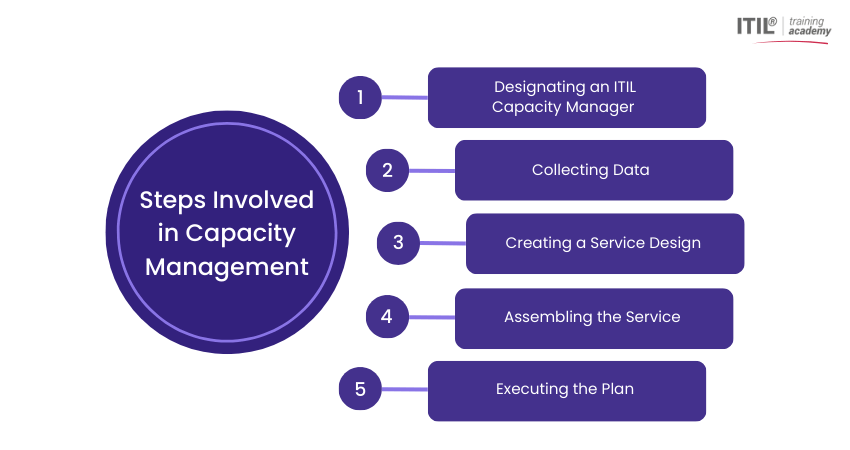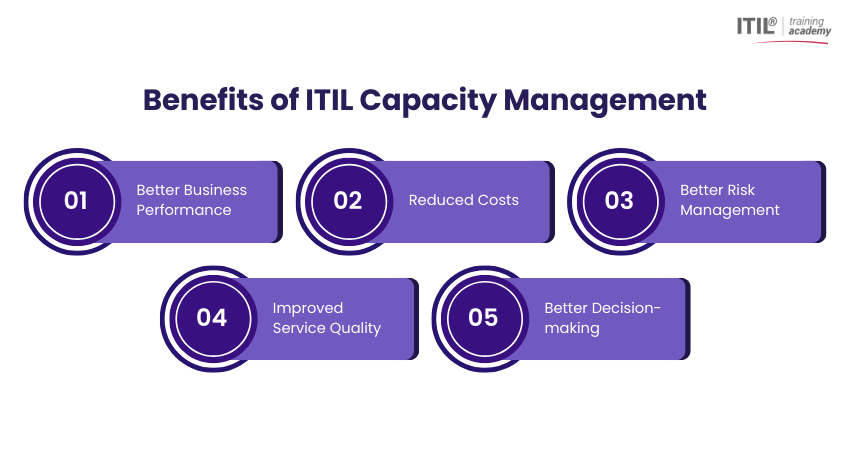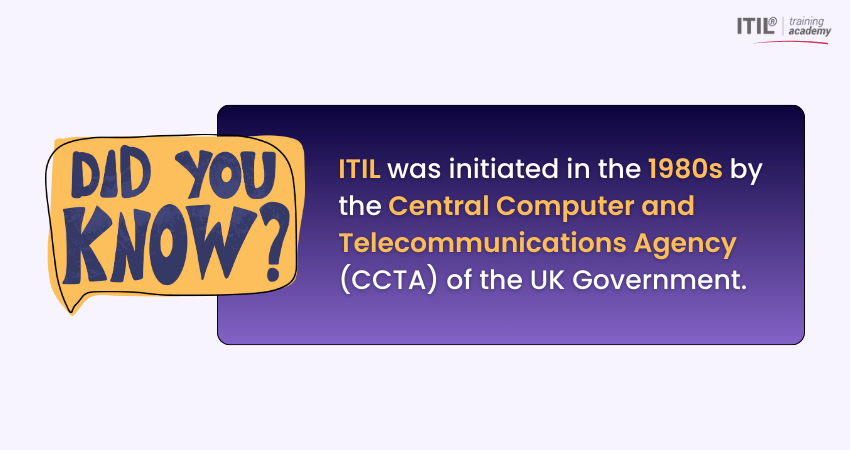
Author-Veronica Davis
Last updated-Sep 6, 2025
Every IT system needs to be a fine-tuned ecosystem where every server, network and application harmonise without missing a beat. In short, seamless IT Service is more than a goal; it’s a necessity and ITIL Capacity Management delivers on it. It’s about making sure your technology always keeps pace with your organisation’s needs, both today and tomorrow.
Blending smart planning with proven best practices helps businesses hit the sweet spot between cost and performance. This blog will take you on an exploration into the power of ITIL Capacity Management, where you'll learn about its numerous benefits. So read on and keep your IT stage perfectly set for success!
Table of Contents
1) What is ITIL Capacity Management?
2) Purpose of ITIL Capacity Management
3) What are the Steps Involved in Capacity Management?
4) What are the Benefits of ITIL Capacity Management?
5) Best Practices for Implementing ITIL Capacity Management
6) Conclusion
What is ITIL Capacity Management?
ITIL Capacity Management is part of the ITIL framework. It ensures IT systems and services can handle both current and future business needs without incurring unnecessary costs. It focuses on checking, analysing, and predicting how IT resources like servers, storage, networks, and applications perform so that services run smoothly. The sole aim is to balance supply and demand.
This process has three parts:
1) Business Capacity Management: It connects IT capacity with business plans. This ensures that the right level of IT resources supports future business growth.
2) Service Capacity Management: It looks at how live services perform. This helps maintain consistent service quality and quickly resolve performance issues.
3) Component Capacity Management: It deals with individual IT elements. By monitoring each component, organisations can spot weaknesses early and optimise performance.
Together, they help organisations keep services reliable, prepare for growth, and make smart choices about IT investments.
Purpose of ITIL Capacity Management
The main aim of ITIL Capacity Management is to deliver quality IT Services at the lowest possible cost. It ensures that resources are neither overused nor left idle, maintaining a balance that supports business goals. By analysing trends and forecasting future needs, it prevents disruptions and prepares systems for growth.
A Capacity Manager’s role is to figure out how much capacity is needed to meet current and future demands quickly and efficiently, while staying within budget. They then track and review the performance of these processes to check speed, reliability, and effectiveness, and identify areas where improvements can be made.
What are the Steps Involved in Capacity Management?
Capacity Management is not a one-time approach. It's an ongoing process that requires planning, monitoring and continuous improvement. Here are the main steps involved in ITIL Capacity Management:

1) Designating an ITIL Capacity Manager
This is the first step of ITIL Capacity Management and involves the following:
1) It's about assigning clear responsibility.
2) A Capacity Manager is appointed to oversee the whole process.
3) Their role is to ensure IT resources meet current and future business needs.
4) In smaller organisations, one person may handle this alongside other IT duties.
5) In larger organisations, a dedicated team may be required.
2) Collecting Data
In this step, identify your organisation’s current IT capacity and future needs. The team must perform the following:
1) Review current resources to understand their usage and limitations.
2) Define capacity objectives that align with business needs.
3) Assess how well existing systems perform.
4) Monitor resources in real time for accuracy.
5) Improve performance by refining tools and methods.
6) Ensure resource planning stays within financial limits.
7) Identify gaps and recommend improvements for long-term growth.
3) Creating a Service Design
In the third step, use the data to design a detailed ITIL Capacity Management plan. Include the following:
1) Budget and cost estimates
2) Required tools, resources and manpower
3) Areas where Capacity Management will be applied
4) Process flow from inputs to outputs
5) Work needed for tools and software setup
6) Training requirements and timelines
7) Full implementation timeline
4) Assembling the Service
Once the design is ready, begin assembling. This step involves the following actions:
1) Check if you need to expand your team
2) Get the required tools and software
3) Document every detail ranging from plans to budgets
4) Ensure that resources and infrastructure are ready for implementation
5) Executing the Plan
This is the final step of the ITIL Capacity Management process where you must perform the following actions:
1) Put the planned service or solution into action.
2) Continuously track progress to measure effectiveness.
3) Identify what is working well and where improvements are needed.
4) Use regular monitoring to maintain efficiency in all the processes.
5) Ensure the capacity can meet both current and future business demands.
Become the IT Service pro who can turn any service requests into prompt results. Sign up for our ITIL® 4 Practitioner: Service Request Management Certification now!
What are the Benefits of ITIL Capacity Management?
ITIL Capacity Management plays an important role in IT Service Management by making sure IT resources are scaled to meet both current and future needs. Here are the key benefits:

1) Better Business Performance: ITIL Capacity Management makes sure that IT resources are optimised. This means services stay available to meet business demands and deliver quality to clients.
2) Reduced Costs: By using resources efficiently, organisations avoid spending on unnecessary hardware, software or tools.
3) Better Risk Management: It highlights possible risks in IT systems and helps prevent downtime, data loss, or other major issues.
4) Improved Service Quality: With capacity properly managed, services are reliable, consistent and delivered at a high standard.
5) Better Decision-making: Clear visibility into IT resources allows smarter decisions about investments, budgets, and service delivery.
Sharpen your skills to detect and diagnose disruptions like never before. Sign up for our ITIL® 4 Practitioner: Incident Management Training now!
Best Practices for Implementing ITIL Capacity Management
As your company grows, you will develop your own ways of improving processes. A good starting point is to learn from practices that work well in other organisations. Here are some best practices to consider:
Assign the Right People to the Right Project
Place the right people in the right roles at the right time. Aim to use skilled staff with industry experience, ideally from within your company, as they already know your culture and services. Having the right expertise in place also reduces errors and accelerates project success.
Run Some “What if” Scenarios
Planning for unexpected events before implementation is always a good idea. You can accomplish this by testing different “what if” situations. Having contingency plans ensures quick responses to errors or bottlenecks and keeps operations running smoothly. This proactive approach strengthens resilience and minimises service disruptions.
Learn From the Past
Avoid repeating mistakes by studying past reports and results. Learning from others’ successes as well as failures can help your implementation deliver better outcomes right from the start. Documenting these insights also creates a valuable knowledge base for future projects.

Prioritise Tasks
Set clear priorities so the most important tasks are completed first. This helps the team stay focused and improves efficiency. Proper prioritisation can reduce downtime and also prevent resources from being wasted on less critical work. It also provides clarity, helping teams stay aligned with overall business goals.
Manage Capacity vs Demand Ratio
Team size alone doesn’t guarantee you have enough capacity to meet demand. Always check resource availability before planning or scheduling work to avoid gaps. Doing so ensures deadlines are realistic and achievable without overloading your staff. Regularly reviewing this ratio helps maintain balance and prevents burnout.
Conclusion
ITIL Capacity Management is essential for maintaining high-performing and cost-efficient IT Services that don't lose sight of business goals. By proactively monitoring and planning capacity, organisations can avoid service disruptions and scale confidently. It ensures that your IT infrastructure is always ready to meet demand, both today and tomorrow. It does so while maximising value and minimising waste.
Build a rock-solid base for smarter and smoother IT operations. Learn how by registering for our ITIL® Foundation Level Training now!
Most Recent
Date - Sep 20, 2025
Date - Sep 20, 2025
Date - Sep 20, 2025





 Back to
Topics
Back to
Topics

























